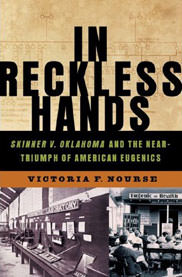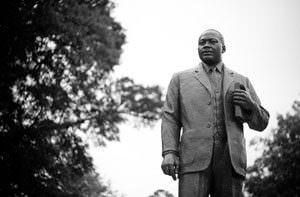Tony Platt on American Eugenics
Here's a story, both chilling and inspiring: how prisoners at an Oklahoma prison in the aftermath of the Depression led a struggle to limit the practice of compulsory sterilization.
The 1942 U.S. Supreme Court case of Skinner v. Oklahoma is remembered for protecting “the right to have offspring,” and by implication the right not to have offspring. Skinner, according to Victoria Nourse, the author of an important new book on American eugenics, typically “sits in the shadow of the abortion and gay marriage debates.”
“In Reckless Hands: Skinner v. Oklahoma and the Near-Triumph of American Eugenics” demonstrates that Skinner also opens a window into a little-known chapter of American eugenics: how prisoners at a hardscrabble prison in Oklahoma in the aftermath of the Depression led a sophisticated struggle to limit the practice of compulsory sterilization in the United States.
Much has been written about the history of eugenics, but until publication of this book we knew little about how eugenic sterilization was used in prisons and against men, and even less about the views of its targeted victims. It’s a lively tale, well told, until the author, a law professor at Emory University, tries her hand at historical generalizations.
At the core of eugenics was a belief in a central role of heredity in both determining and explaining social inequality. Influenced by 19th-century developments in genetics, medicine and public health, eugenics was not a crank science. At the height of its influence, support came from some unlikely ideological bedfellows. It was endorsed by Fabian socialists in England and racial scientists in Germany; linked to birth control and progressive economic reforms in Denmark, and to racial policies against itinerant gypsies in Sweden; an expression of Fascist ideology in Germany and Argentina, and of cultural hybridity in Mexico; and closely associated with the sterilization of those defined as “feebleminded” in Germany, the United States, Sweden and Denmark.
In the 1930s, Nazi Germany made eugenics an official state policy, first openly sterilizing hundreds of thousands of women, then secretly murdering many of its disabled and mentally ill patients judged leading “lives unworthy of life.” Until the onset of World War II, when selective murder turned into organized butchery, Nazi racial scientists were appreciated around the world, especially in the United States, where eugenics was dominated by right-wing hard-liners.
American eugenicists boosted “Anglo-Saxon” and “Nordic” types as the engine of modern society and promoted policies of apartheid to protect the “well born” from contamination by impoverished and mentally ill “degenerates.” Believing that social failure and success could be traced to “racial temperament,” its leaders advocated “positive eugenics” to increase the birthrate of privileged, white families, and “negative eugenics” to reduce the birthrate of groups considered a burden on civilization.
In addition to promoting utopian visions of a brave new world and exploiting cultural anxieties about racial degeneracy, eugenic scientists were hands-on activists, campaigning against “miscegenation,” and in favor of welfare and immigration restrictions. Their greatest success in the United States during the first half of the 20th century was lobbying for the compulsory sterilization of 60,000 mostly poor women, considered “feebleminded” or “socially inadequate.”
Until recently, the conventional scholarly wisdom claimed that Hitler’s reign of terror ended scientific infatuation with eugenics. Writing in 1963, Mark Heller argued that by the time of World War II, racism ceased to have scientific respectability and “as a result, American eugenics and racism faced a parting of the ways.” In 1985, Daniel Kevles, the distinguished historian of science, similarly made the case that “the Nazi horrors discredited eugenics as a social program.”
But spurred by interest in the relationship between the new genetics and old eugenics, and by concerns about the misuses of science and medicine, a new generation of scholars is revising how we understand the timeline and scope of eugenics. They have drawn attention to the ties between biological theories of race and nation building; to the rebranding of pre-World War II eugenics as population control in the 1950s; and to contemporary uses of hereditarian arguments to bolster anti-feminism and justify racial inequality.
“In Reckless Hands” focuses on the use of sterilization against poor white men in Oklahoma during the 1930s and 1940s and adds a new dimension to our understanding of class prejudices within the American eugenics movement.
In 1931, Oklahoma followed the lead of many states by passing a law authorizing sterilization of persons in institutions “afflicted with hereditary forms of insanity,” as well as “idiocy, imbecility, feeblemindedness, or epilepsy.” The state Legislature added two more grounds for sterilization in 1933: If the patient was “likely to be a public or partial public charge” or was a “habitual criminal,” defined as “any person convicted of a felony three times.”
Two years later, in an atmosphere of moral panic about crime, Oklahoma passed the Habitual Criminal Sterilization Act, which made prisoners convicted of two felonies involving “moral turpitude” subject to sterilization. The state Senate made sure that politicians and their cronies would preserve their right to have offspring by exempting “offenses arising out of violations of the prohibitory laws, revenue acts, embezzlement or political offenses.”
By 1934, Warden Sam Brown of McAlester prison was under political pressure to prepare a list of prisoners suitable for sterilization. He was reluctant to comply, worrying that “if Oklahoma tried to sterilize McAlester inmates, there would be violence at the prison. Riots or worse.” Most of the prisoners were drifters, day laborers and sharecroppers who for the most part had committed economic crimes of desperation. As Brown himself admitted, the Depression had turned “honest laborers to crime.”
Conditions inside McAlester were rough for the 2,000 incarcerated men. Hard labor in a brick-making factory was routine, with infractions punished by beatings, time in the hole, and humiliation, such as being forced to wear pink panties and dresses. Breakouts and violence were common, but there was little organized resistance until prisoners formed a committee in 1934 to protest the sterilization policy.
The odds were heavily stacked against the prisoners. In the infamous Supreme Court decision of 1927, Buck v. Bell, Justice Oliver Wendell Holmes had justified the sterilization of 17-year-old Carrie Buck on the grounds that “three generations of imbeciles [were] enough.” During the 1930s, public opinion overwhelmingly favored sterilization of “habitual criminals.” And professional and academic opinion backed up public prejudices. In Oklahoma, Dr. Louis Henry Ritzhaupt, a Democratic senator and eugenics crusader, campaigned for the 1933 sterilization law as the best way “to stop production of potential inmates.” At Harvard, leading criminologists Sheldon and Eleanor Glueck advocated similar measures to “reduce the reproduction” of criminals.
At the heart of this book is a fascinating account of an eight-year struggle, led by prisoners, to get the U.S. Supreme Court to strike down Oklahoma’s Habitual Criminal Act. The original leaders of the campaign were Francis Hyde, a lawyer in prison for attempted murder, forgery and bank robbery; Ralph Bainum, a lifer in for murder; and J.J. Kelly, a “master thief” with training in law. With the moral support of the ACLU and national figures such as Clarence Darrow, and sympathetic coverage by the local media, the prisoners of McAlester involved themselves in the daily tasks of a long-term political campaign. A prisoners’ committee raised $1,000 from McAlester’s canteen fund and hired well-connected lawyers: Fay Lester, a former chief justice of the Oklahoma Supreme Court, and Claud Briggs, a populist leader in the Senate who had made his reputation fighting for the “masses against the classes.” The prisoners held media-savvy demonstrations inside the prison — with placards proclaiming “Save Your Manhood” and “Contribute here to the Sterilization Campaign” — and lobbied the Tulsa Daily World to publish “A ‘Life Termer’ Denounces Sterilization,” a smart essay written by “Convict No. 18051.”
After a prisoner targeted for sterilization escaped in 1936, the state settled on a candidate who would pass judicial scrutiny. Jack Skinner was a short, skinny three-time loser with a limp, who had done time for chicken stealing and armed robberies. His first sterilization trial lasted less than a day. The appeal process took almost five years, until 1941, when Oklahoma’s Supreme Court in a split decision affirmed the decision to sterilize McAlester’s test case, even though by then Skinner had been paroled, had married and had moved to California.
In 1942, with a couple of small-town, inexperienced trial lawyers added to Skinner’s team, the U.S. Supreme Court heard the case of Skinner v. Oklahoma. In a unanimous decision, the court decided for Skinner: “The power to sterilize, if exercised, may have subtle, far reaching and devastating effects. In evil or reckless hands it can cause races or types which are inimical to the dominant group to wither and disappear.” In the lead opinion, Justice William O. Douglas exposed the double standard of a law that punished “a person who enters a chicken coop and steals chickens,” while exempting the white-collar criminal who “appropriates over $20 from his employer’s till.”
It was an extraordinary victory — greeted “with jubilation in the cells and trusty buildings” — for an improbable campaign begun in McAlester prison eight years earlier. While the Skinner case did not provide protection for women in institutions or on welfare, “at a minimum,” notes Victoria Nourse, “legislative expansion of compulsory sterilization was suspect.”
When the author sticks close to the details of this compelling story, “In Reckless Hands” is a fascinating tale. But when she ventures into historical analysis, the book loses traction. For it is then that the author tends to sacrifice complexity for pithiness, and to make too many sweeping, and sometimes inaccurate, generalizations. It’s facile, for example, to reduce the successes of Nazism to the conclusion that “the German public embraced Hitler as the last chance for a bit of order.” Or to suggest, without evidence, that the rise of Nazism was responsible for transforming the American “public’s understanding of racism from a matter of science into one of politics” — a point which Nourse herself contradicts in the epilogue: “It became obvious [in the 1940s] that the racism of eugenics would not die.” (The book’s subtitle adds to this confusion.)
Also, the author doesn’t need to inflate the importance of her book by suggesting that it is somehow groundbreaking to do research “in local archives where most fear to tread,” or ingenuously arguing that the history of eugenics “has largely been forgotten” — I have at least 15 books on my shelf written on this topic since the mid-1980s.
Nevertheless, “In Reckless Hands” is well worth reading because it gets us to think in new ways about the scope of eugenics. Moreover, by bringing us face to face with some of the typically anonymous victims of forced sterilization, Victoria Nourse teaches the important lesson that the masses can take on the classes.
Tony Platt, professor emeritus at Sacramento State University, is the author, with Cecilia O’Leary, of “Bloodlines: Recovering Hitler’s Nuremberg Laws, From Patton’s Trophy to Public Memorial.”
History of Eugenics: a Select Bibliography
Black, Edwin. “War Against the Weak: Eugenics and America’s Campaign to Create a Master Race.” New York: Four Walls Eight Windows, 2003.
Briggs, Laura. “Reproducing Empire: Race, Sex, Science, and U. S. Imperialism in Puerto Rico.” Berkeley: University of California Press, 2002.
Broberg, Gunnar and Nils, Roll-Hanjsen (eds.). “Eugenics and the Welfare State: Sterilization Policy in Denmark, Sweden, Norway, and Finland.” Michigan State University Press, 1996.
Carlson, Elof Axel. “The Unfit: A History of a Bad Idea.” Cold Springs Harbor, N.Y.: Cold Springs Harbor Laboratory Press, 2001.
Davis, Angela Y. “Racism, Birth Control and Reproductive Rights,” in “Women, Race & Class.” New York: Random House, 1981.
“Facing History and Ourselves. Race and Membership in American History: The Eugenics Movement.” Brookline, Mass: Facing History and Ourselves National Foundation, 2002.
Ley, Astrid and Morsch, Günter. “Medical Care and Crime: The Infirmary at Sachsenhausen Concentration Camp, 1936-1945.” Berlin: Metropol Verlag, 2007.
Gordon, Linda. “The Moral Property of Women: A History of Birth Control Politics in America.” Chicago: University of Illinois Press 2002.
Haller, Mark. “Eugenics: Hereditarian Attitudes in American Thought.” New Brunswick: Rutgers University Press, 1963.
Kevles, Daniel. “In the Name of Eugenics: Genetics and the Uses of Human Heredity.” Cambridge: Harvard University Press, 1985, 1995.
Kline, Wendy. “Building a Better Race: Gender, Sexuality, and Eugenics from the Turn of the Century to the Baby Boom.” Berkeley: University of California Press, 2001.
Kühl, Stefan. “The Nazi Connection: Eugenics, American Racism, and German National Socialism.” New York: Oxford University Press, 1994.
Kuntz, Dieter and Bachrach, Susan (eds). “Deadly Medicine: Creating the Master Race.” Washington, D.C.: United States Holocaust Memorial Museum, 2004.
LaPan, Amy and Platt, Tony ” ‘To Stem the Tide of Degeneracy’: The Eugenic Impulse in Social Work,” in Stuart A. Kirk (ed.), “Mental Disorders in the Social Environment: Critical Perspective.” New York: Columbia University Press, 2005.
Molina, Natalia. “Fit to Be Citizens? Public Health and Race in Los Angeles, 1879-1939.” Berkeley: University of California Press, 2006.
Nourse, Victoria F. “In Reckless Hands: Skinner v. Oklahoma and the Near Triumph of American Eugenics.” New York: W.W. Norton, 2008.
Ordover, Nancy. “American Eugenics: Race, Queer Anatomy, and the Science of Nationalism.” Minneapolis: University of Minnesota Press, 2003).
Platt, Tony (with Cecilia O’Leary). “Bloodlines: Recovering Hitler’s Nuremberg Laws, From Patton’s Trophy to Public Memorial.” Boulder: Paradigm Publishers, 2006.
Platt, Tony. Reviews of books on eugenics: “The Great White Hope,” Los Angeles Times, April 14, 2002; “Breeding Only the Best,” Los Angeles Times, Sept. 7, 2003; “In and Out of the Shadow of the Holocaust,” Social Justice, April 2006.
Quine, Maria Sophia. “Italy’s Social Revolution: Charity and Welfare From Liberalism to Fascism.” Houndmills, Basingstoke: Palgrave, 2002.
Quine, Maria Sophia. “Population Politics in Twentieth-Century Europe: Fascist Dictatorships and Liberal Democracies.” London: Routledge, 1996.
Stepan, Nancy Leys. ” ‘The Hour of Eugenics’: Race, Gender, and Nation in Latin America.” Ithaca: Cornell University Press, 1991.
Stern, Alexandra Minna. “Eugenic Nation: Faults and Frontiers of Better Breeding in Modern America.” Berkeley: University of California Press, 2005.
Turda, Marius and Weindling, Paul J. “Blood and Homeland: Eugenics and Racial Nationalism in Central and Southeast Europe, 1900-1940.” Budapest: Central European University Press, 2007.
Your support matters…Independent journalism is under threat and overshadowed by heavily funded mainstream media.
You can help level the playing field. Become a member.
Your tax-deductible contribution keeps us digging beneath the headlines to give you thought-provoking, investigative reporting and analysis that unearths what's really happening- without compromise.
Give today to support our courageous, independent journalists.









You need to be a supporter to comment.
There are currently no responses to this article.
Be the first to respond.